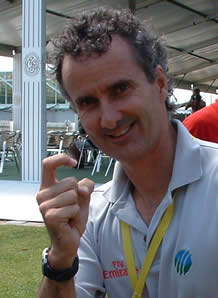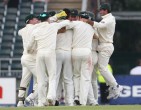Referrals; who needs them? We do.
Corey Taylor |
Who needs referrals? We do.
Prior to the commencement of the most eagerly anticipated Test series since the Ashes in 2005, the zeitgeist had been one of looking ahead. The Australian team has been in a period of transition for a while, the Indians will begin the same process some time after the current Test series and other teams have exciting young players replacing the previous generation and are starting to make their mark. The Indians are certainly talking about changes of guards, the press reporting all sorts of scraps about forced retirements and pressure to perform or else. Before the current series, India and Sri Lanka played out a gritty Test series that unearthed the next spinning giant and Twenty 20 cricket has well-and-truly arrived with its myriad of tournaments not related to one`s birth country and corresponding fattening pay packets of the players. The game, as a whole, was looking fresh.
This progress has been checked somewhat with the reticence to introduce a referral system for India`s home Test series against Australia. Whilst it`s unclear exactly who vetoed its use, the system was widely considered a success in India`s last Test series after trials during the last English county season so its absence is baffling and retrograde. That Indian players are unwilling to adopt Ricky Ponting`s proposal of accepting the fielder`s word in catch disputes further deepens the need for players to have the ability to refer some decisions to the 3rd umpire and satiate the requirement for precision in the tense contests these sides are apt to play, particularly as during the course of yesterday`s play, it didn`t take long to see where such as system may have changed doubtful decisions into correct ones.
As early as the fourth delivery of the match, where Matthew Hayden was given out caught behind when it`s likely his bat hit pad and not ball, proof of its utility was starkly demonstrated. This dismissal put the Australians on the back-foot but the Indian team wasn`t unaffected by the inability to call for referrals as the Australian team recovered to be in a good position by the end of the day. In the 35th over of the day, Simon Katich should have and would have been given out LBW to Anil Kumble had the decision been referred and Ricky Ponting may not have survived a decision late in the day when a checked drive landed in Anil Kumble`s hands but was deemed a bump-ball. Similarly, the decision to give Ricky Ponting out soon after might have been referred and likely given not-out as it looked as if it was missing leg-stump. That the system isn`t being used is looking like an embarrassment already, particularly in the context of the umpiring disputes during the last series between the two sides only a few months ago.
Even then, the system trialled does not go far enough in some ways. For example, the Hawkeye system used by the 3rd umpire will only give them the line of the ball up to contact with the batsman. This, I believe, is a cop-out. The prediction system is based on calculations which aren`t rocket science so surely the predictive track would be more accurate than the video screen view of the 3rd umpire and all associated parallax errors. The technology is good enough, there`s no reason not to use it.
An unintended but positive consequence of introducing referrals may be the re-emergence of spin bowling. Nullified by slow pitches, heavy bats and the LBW rule as spinners have been for decades now, decisions able to referred may bring them to the forefront of the game. Batsmen will likely be a little more wary of wantonly thrusting pad with bat well behind to balls in line with the stumps as getting far forward won`t be enough to save them. This would necessitate a greater attempt to bring the bat into play, inducing more edges to close-in fielders. Batsmen would also have to play more with their bats at deliveries outside off moving back into them hence increasing the chance of being bowled through the gate and shots being skied. For a long time, batsman have been relatively safe in using their pads to nullify spin and being forced to use their bat more increases the chance of wickets for spinners, a move to be applauded to those of us wanting to see less of such negative play. All that said, with the number of referrals limited, this effect may be less pronounced than one would think. We will have to wait and see on that one.
There is simply no defensible reason for the referral system not to be instituted in all top-level cricket. The system is by no means perfect but enjoys the universal support of players and pundits alike. Lack of accuracy and precision isn`t viewed as a quaint side-effect to a game for traditionalists any more, it`s a sign that cricket needs to move with the times. Hopefully this ridiculous situation where useful technology is wilfully under-utilised won`t continue beyond this Test series.





Leave a comment